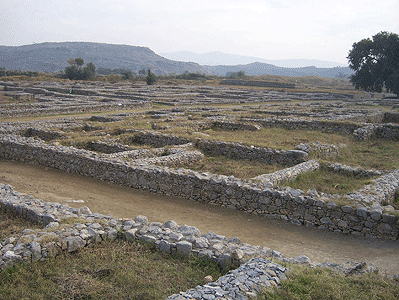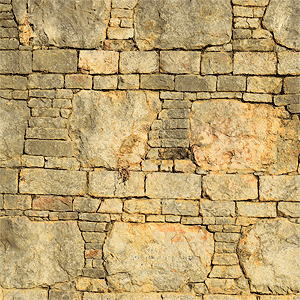
Sirkap (Taxila)



This important caravan city was located in the Gandara region on the river bank opposite to the current city of Taxila, Punjab, Pakistan, on the ancient Silk Road, which connected it to the Eastern and Western cultures of Greece, Rome, India and China. The roots of the city extend back to 1000 BCE.
During his Indus Valley invasion in 326 BCE, Alexander the Great overtook Taxila without a battle. Sirkap was later constructed by the Greco-Bactrians in 180 BCE in the "Hippodamian" grid-plan--characteristic of Greek cities. Organized around one main avenue and fifteen perpendicular streets, it covers a surface of around 1,200 by 400 meters (3,900 ft × 1,300 ft), with a surrounding wall 5–7 meters (16–23 ft) wide and 4.8 kilometers (3.0 mi) long.
The Greek philosopher Apollonius of Tyana, who visited Sirkap in the 1st century CE, described the city's defensive wall and the houses, which "were built in such a way that if you look at them from outside they had only one story, while if you went into one of them, you at once found subterranean chambers extending as far below the level of the earth as did the chambers above".
Sirkap was Invaded many times, first by the Indo-Scythians and later by the Indo-Parthians, who rebuilt the city after an earthquake in 30 CE and added a temple to the sun god and the Buddhist stupas (reliquary shrines of Buddha and his disciples).
The architectural styles and decorations of the oldest Buddhist stupas in India located at Sirkap, indicate a cross influence and integration of Hellenistic Greek, Vedic Hindu, Jain, and Zoroastrian religious cultures. The Apsidal Temple built by Greeks (slightly larger than the Parthenon) was rebuilt by Buddhists after the 30 CE earthquake.
The Dharmarajika Stupa, about a kilometer to the southeast, is a large stupa that dates from the 2nd century CE. The stupa was built to house relics of the Buddha, surrounded by monastic buildings and served the comminity of Sirkap.(see pages ).
The archaeological excavation of the old city was carried out under the supervision of Sir John Marshall by Hergrew from 1912–1930.
Elevation is c. 508 meters (1666 feet) above sea level.
Materials: Walls of stone (in the pattern shown here, possibly plastered), with wood roof structure (possibly with clay and plaster roofing layers).
Data for this CG model from:
1.Varma, Supriya, (unknown date); Early HIstoric Cites in the Taxila Valley: Archaeological Perspectives, Centre for Historical Studies, Jawaharlal Nehru University, New Delhi.
2.Marshall, J.,(1951) An Illustrated Account of ARchaeologial Excavations 1913-1934, Volumes I-III (Cambridge: Cambridge University Press).
3. W. Rienjang, 'Sirkap (Taxila)', Gandhara Connections website,
http://www.carc.ox.ac.uk/GandharaConnections/otherResources.htm





